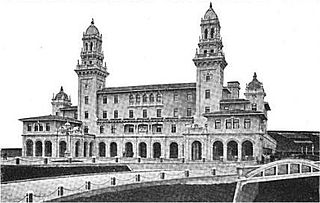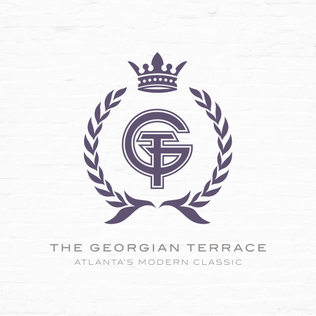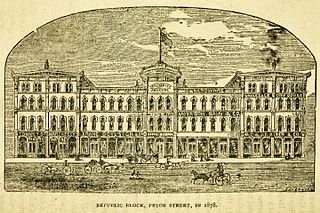Related Research Articles

Atlanta is the capital and most populous city of the U.S. state of Georgia. With a population of 498,715 living within the city limits, it is the 38th most populous city in the United States according to the 2020 U.S. census However, it serves as the cultural and economic heart of the much larger Atlanta metropolitan area, home to 6,089,815 people, making it the ninth-largest metropolitan area in the United States. It is the seat of Fulton County, the most populous county in Georgia. Situated among the foothills of the Appalachian Mountains at an elevation of just over 1,000 ft above sea level, it features unique topography that includes rolling hills, lush greenery, and the most dense urban tree coverage of any major city in the United States.

Oglethorpe University is a private liberal arts college in Brookhaven, Georgia, US. Originally chartered in 1835, it was named in honor of General James Edward Oglethorpe, founder of the Colony of Georgia.

The Battle of Atlanta was a battle of the Atlanta Campaign fought during the American Civil War on July 22, 1864, just southeast of Atlanta, Georgia. Continuing their summer campaign to seize the important rail and supply hub of Atlanta, Union forces commanded by William Tecumseh Sherman overwhelmed and defeated Confederate forces defending the city under John Bell Hood. Union Maj. Gen. James B. McPherson was killed during the battle. Despite the implication of finality in its name, the battle occurred midway through the campaign, and the city did not fall until September 2, 1864, after a Union siege and various attempts to seize railroads and supply lines leading to Atlanta. After taking the city, Sherman's troops headed south-southeastward toward Milledgeville, the state capital, and on to Savannah with the March to the Sea.

The history of Atlanta dates back to 1836, when Georgia decided to build a railroad to the U.S. Midwest and a location was chosen to be the line's terminus. The stake marking the founding of "Terminus" was driven into the ground in 1837. In 1839, homes and a store were built there and the settlement grew. Between 1845 and 1854, rail lines arrived from four different directions, and the rapidly growing town quickly became the rail hub for the entire Southern United States. During the American Civil War, Atlanta, as a distribution hub, became the target of a major Union campaign, and in 1864, Union William Sherman's troops set on fire and destroyed the city's assets and buildings, save churches and hospitals. After the war, the population grew rapidly, as did manufacturing, while the city retained its role as a rail hub. Coca-Cola was launched here in 1886 and grew into an Atlanta-based world empire. Electric streetcars arrived in 1889, and the city added new "streetcar suburbs".

The 46 Knox-class frigates were the largest, last, and most numerous of the US Navy's second-generation anti-submarine warfare (ASW) escorts. Originally laid down as ocean escorts, they were all redesignated as frigates on 30 June 1975, in the 1975 ship reclassification plan and their hull designation changed from 'DE' to 'FF'. The Knox class was the Navy's last destroyer-type design with a steam turbine powerplant.

Clark Atlanta University is a private Methodist historically black research university in Atlanta, Georgia. Clark Atlanta is the first Historically Black College or University (HBCU) in the Southern United States. Founded on September 19, 1865, as Atlanta University, it consolidated with Clark College to form Clark Atlanta University in 1988. It is classified among "R2: Doctoral Universities – High research activity".

The Emory University School of Medicine is the graduate medical school of Emory University and a component of Emory’s Robert W. Woodruff Health Sciences Center. Before it was established as the Emory School of Medicine in 1915, the school first began as the Atlanta Medical College. Founded in 1854 by a group of physicians led by Dr. John G. Westmoreland, the college began during unfavorable financial conditions along with competition of three other medical schools opening in the state, driving up competition for students. Despite these challenges, the Atlanta Medical College continued operation until August 1861 when classes were suspended due to the Civil War. Several years later, the College merged with the Southern Medical College, leading to the creation of the Atlanta College of Physicians and Surgeons in 1898. The College existed for 14 years before another merger took place, this time due to encouragement from the Council of Medical Education. The Council promised that if the Atlanta College of Physicians and Surgeons merged with the Atlanta School of Medicine, they would receive a Class A rating. After the merger, the American Medical Association began pressuring medical schools to align with universities in order to improve the quality of medical education nationwide. Just two years after the formation of the second version of the Atlanta Medical College, the College combined with Emory University, which was in its initial stages of development and sought to add medical education to its offerings. On June 28, 1915 the Emory School of Medicine was established.
Standing Peachtree was a Creek Indian village and the closest Indian settlement to what is now the Buckhead area of Atlanta, Georgia. It was located where Peachtree Creek flows into the Chattahoochee River, in today's Paces neighborhood. It was located in the borderlands of the Cherokee and Creek nations. It is referred to in several documents dating as far back as 1762.
The Kimball House was the name of two historical hotels in Atlanta, Georgia. United States. Both were constructed on an entire city block at the south-southeast corner of Five Points, bounded by Whitehall Street, Decatur Street, Pryor Street, and Wall Street, a block now occupied by a multi-story parking garage.

Reinhardt University is a private university in Waleska, Georgia. The university has an off-campus center in Alpharetta and offers some programs in Cartersville, Marietta, and Canton, and online. Reinhardt is affiliated with the United Methodist Church.

USS Joseph Hewes (FF-1078) was a Knox-class frigate of the US Navy. She is in service with the Republic of China Navy as the ROCN Lan Yang (FFG-935).

Terminal Station was the larger of two principal train stations in downtown Atlanta, Union Station being the other. Opening in 1905, Terminal Station served Southern Railway, Seaboard Air Line, Central of Georgia, and the Atlanta and West Point. The architect was P. Thornton Marye, whose firm also designed the Fox Theater and Capital City Club in downtown Atlanta, as well as the Birmingham Terminal Station.

Malmö Idrottsplats, commonly referred to simply as Malmö IP and sometimes as Gamla IP, is a stadium in Malmö, Sweden, that is primarily used for association football. As of 2015, it is the home of women's association football club FC Rosengård, currently playing in Damallsvenskan; the men's clubs Malmö FF and IFK Malmö have played there in the past. The stadium is the third largest in Malmö behind Malmö Stadion and Stadion, the current home grounds of IFK Malmö and Malmö FF respectively. The Sweden national football team has played at Malmö IP twice, in 1929 and 1949. The stadium's capacity has changed throughout the years with various redevelopments and renovations; it is today 7,600, but was historically much higher. The record attendance at the ground was set on 1 June 1956 when 22,436 people attended an Allsvenskan match between Malmö FF and Helsingborgs IF.

The Georgian Terrace Hotel in Midtown Atlanta, part of the Fox Theatre Historic District, was designed by architect William Lee Stoddart in a Beaux-Arts style that was intended to evoke the architecture of Paris. Construction commenced on July 21, 1910, and ended on September 8, 1911, and the hotel opened on October 2, 1911. The George C. Fuller Construction Company was contractor, and the developer was Joseph F. Gatins, Jr.
Louis De Votie Newton was President of the Southern Baptist Convention (1947–1948) in the United States, Baptist preacher, and author, as well as vice president of the Baptist World Alliance.
The Atlanta Neighborhood Union was an African-American, women-led neighborhood organization in Atlanta, Georgia, started in 1908 by Lugenia Burns Hope, and chartered in 1911. The Union, "a prototype for self-help and social service organizations," was one of the most important organizations for Atlanta's social services, and worked in part by networking with the city's progressive whites. One of the organizations influenced by it was the Women's Political Council, of Montgomery, Alabama. It was dissolved in the 1970s.
Joyland is a neighborhood of small, single family homes in southeast Atlanta, Georgia and site of a former 1921 amusement park built for African Americans.
Blandtown is a neighborhood of the West Midtown area of Atlanta, Georgia. It is located along either side of Huff Road from Howell Mill Road west to Marietta Blvd. It was one of the first black settlements around Atlanta after the Civil War, named for a Black man who owned property. As a community it declined from the 1950s through 1990s, following racially motivated rezoning and a general flight from cities to suburbs. It now forms part of the West Midtown area, a rapidly developing part of Atlanta known for its home furnishings stores, new apartment and condo complexes, restaurants and bars.

The Republic Block was at the time of its completion one of the most remarkable commercial constructions in Atlanta. It faced Pryor Street between Decatur St. and Railroad Ave., now site of Georgia State University buildings. It faced the Kimball House which stood across Pryor St. to the northwest. The block was built on the initiative of William Goodnow, a manager for the Republic Insurance Company of Chicago, with partners ex-governor Joseph E. Brown, Judge O. A. Lochrane, and othersIts first tenants were hardware mostly wholesale and other dealers, as well as an architect, attorney, a bank, the Atlanta Chamber of Commerce, as well as the Republic Insurance Company.
The Atlanta sanitation strike of 1977 was a labor strike involving sanitation workers in Atlanta, Georgia, United States. Precipitated by wildcat action in January, on March 28 the local chapter of the American Federation of State, County and Municipal Employees (AFSCME) agreed to strike. The main goal of the strike was a $0.50 hourly wage increase. With support from many community groups, Atlanta mayor Maynard Jackson resisted the strike, firing over 900 striking workers on April 1. By April 16, many of the striking workers had returned to their previous jobs, and by April 29 the strike was officially ended.